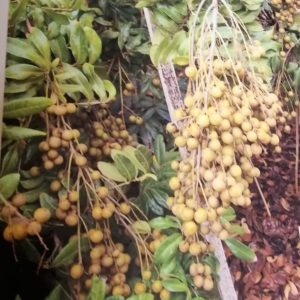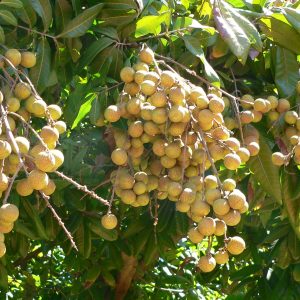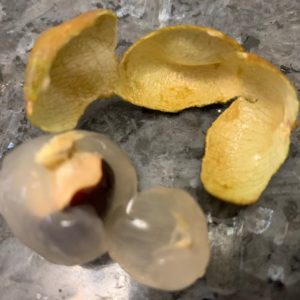Dimocarpus (Euphoria) longan
Longan, dragon’s eye
Origin
Native to South East Asia and has been cultivated in China for millennia. China, Thailand and Taiwan are the major producers worldwide.
Climate
It is a sub-tropical tree but will grow well in tropical climates up to 500m with seasonal wet and dry periods. Sufficient rainfall is 1500-3000mm pa. Temperatures of 20-30°C during spring, 27-35°C in summer and >15°C in winter give best production. It favours the cooler months to be dry and the warmer wet. There is no frost tolerance.
Plant Description
Longan is a symmetrical slow-growing evergreen tree, 8-12m tall, with a dense canopy. It can be semi-deciduous in cooler climates. The shiny leathery alternate dark green leaves, 1-30cm long, are compound paripinnate with 6-9 pairs of leaflets. Growth occurs in several flushes each season.
Relatives
Sapindaceae Family. Related to litchi, rambutan, pulasan, akee, mamoncillo.
Soils
Undemanding, including sandy loams and calcareous or rocky soils, with a preference for pH5-6.5. It does not withstand flooding.
Propagation
Seeds are recalcitrant, lose viability quickly and do not come true to type, but can be used as rootstocks. Air layering and grafting are the principal methods used, but cuttings are also possible.
Cultivars
The most common in Australia is Kohala, but others are Biew Kiew, Chompoo and Haew. Dwarfing rootstocks have been reported by the Chinese. Some cvs have a high percentage of aborted seeds, similar to ‘chicken tongue’ seeds in litchi.
Flowering and Pollination
Upright terminal inflorescences, 10-40cm long, widely branched and occur as panicles of numerous cymules. The greenishyellow to brownish flowers are small with 5-6 sepals and petals, 6-8 stamens and a bi-lobed pistil. There are 3 different flower types – staminate, hermaphrodite functioning as pistillate (20% of total) and hermaphrodite functioning as staminate. The normal flowering sequence is in this order, but can be influenced by management or climatic conditions. Individual panicles flower at different times so there is usually sufficient overlap for pollination, commonly by bees. However, there can be significant self-incompatibility. Alternate bearing is very common with longan and is primarily due to insufficient cool winter temperatures for flower initiation; 15-22°C for 2-3 months is necessary. Poor fruit set occurs above 33°C.
Cultivation
They do best in full sun. The goal with young trees is to maximise appropriate vegetative growth until flowering commences. Water and fertilizer should then be withheld during Winter. NPK with trace elements should be given in 3-4 applications during the warmer months, with amounts increasing depending on tree size. Mulching is beneficial.
Wind Tolerance
They have marginal tolerance of wind and this is improved with attention to structure and size.
Pruning
After planting remove branches with narrow crotch angles. Select 3-4 main scaffold branches to contain height and facilitate light penetration throughout the canopy with maturity. They should be maintained at 3-4m height for ease of harvesting. An important operation is the pruning of many flower-bearing twigs with 3/4 of the flower spikes in the cluster being removed. Later, the fruit clusters are also thinned, in order to increase the size and quality of the fruits. Finally, after fruiting is finished, the ends of the branches that produced the fruit should be cut back at least 45cm unless the tree is very small.
The Fruit
These are spherical-ovoid drupes, 1.5-2cm in diameter and 8-20g. The thin, leathery, rough skin is green when immature and then changes to light brown or tan with maturity, with whitish translucent, sweet and musky flesh with one central shiny brown or black seed which can be easily removed. The flesh is a better source of vitamin C than oranges and contains 15-20% carbohydrate.
Fruit Production and Harvesting
Vegetatively propagated plants can fruit in 2-3 years from planting. Yields will steadily increase over several years, with 25-75kg/tree possible by year 10. Panicles may have a large number of fruit set (>300), but without thinning the terminal parts they will be small and lacking in flavour. Fruit are harvested when ripe by a taste test and then picked by cutting off the whole panicle. Fruit sweetness does not improve after picking and storage at ambient temperature is short. In a crisper they may last for 5-7 days.
Fruit Uses
They are normally eaten fresh but can also be frozen, dried or canned.
Pests and Diseases
These are usually minor, but can include scales, aphids, leaf-eating caterpillars and mealy bugs. Birds might cause trouble.
Comments
Many people would grow this plant purely for its aesthetic value. But for fruit production and provided you have a named cv, the main issues will be an appropriate fertilizing regime, water as our wet winters and dry summers are contrary to preferred, and attempting to smooth out any alternate bearing behaviour. Longans are easier to crop than litchis in our climate and have comparable fruit qualities.


